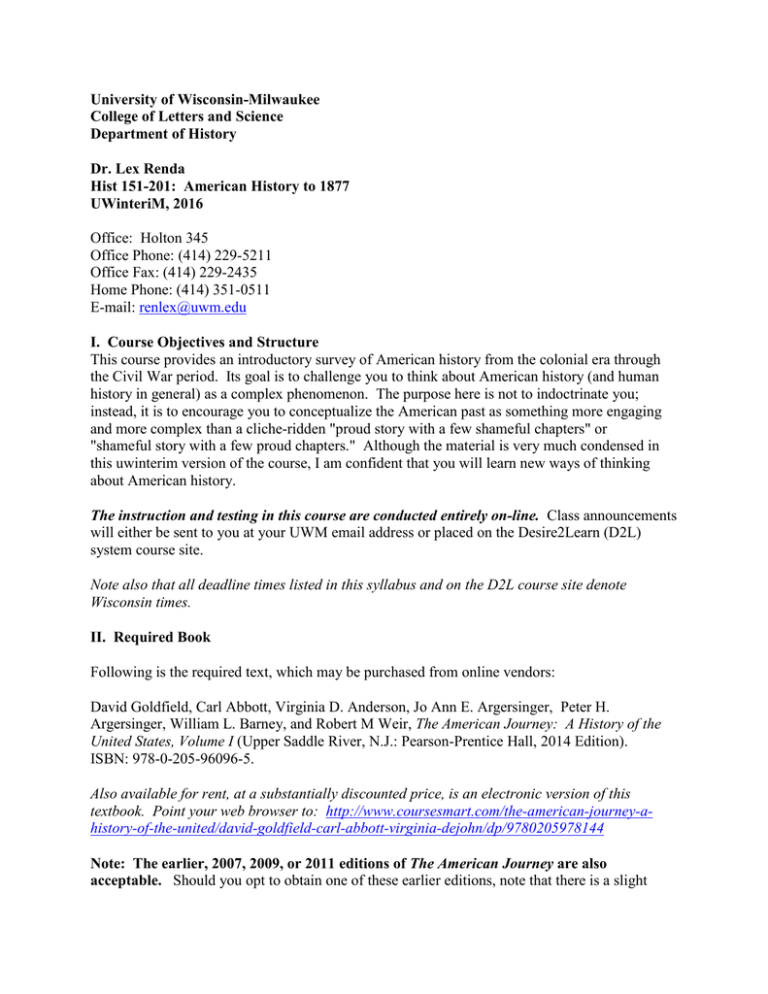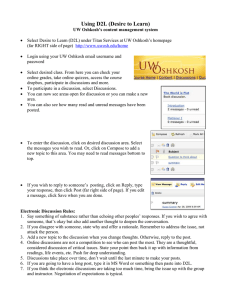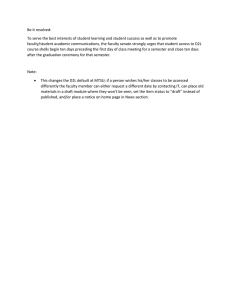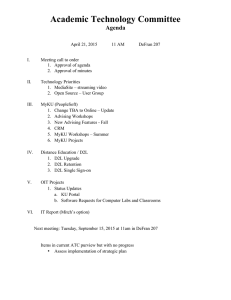
University of Wisconsin-Milwaukee
College of Letters and Science
Department of History
Dr. Lex Renda
Hist 151-201: American History to 1877
UWinteriM, 2016
Office: Holton 345
Office Phone: (414) 229-5211
Office Fax: (414) 229-2435
Home Phone: (414) 351-0511
E-mail: renlex@uwm.edu
I. Course Objectives and Structure
This course provides an introductory survey of American history from the colonial era through
the Civil War period. Its goal is to challenge you to think about American history (and human
history in general) as a complex phenomenon. The purpose here is not to indoctrinate you;
instead, it is to encourage you to conceptualize the American past as something more engaging
and more complex than a cliche-ridden "proud story with a few shameful chapters" or
"shameful story with a few proud chapters." Although the material is very much condensed in
this uwinterim version of the course, I am confident that you will learn new ways of thinking
about American history.
The instruction and testing in this course are conducted entirely on-line. Class announcements
will either be sent to you at your UWM email address or placed on the Desire2Learn (D2L)
system course site.
Note also that all deadline times listed in this syllabus and on the D2L course site denote
Wisconsin times.
II. Required Book
Following is the required text, which may be purchased from online vendors:
David Goldfield, Carl Abbott, Virginia D. Anderson, Jo Ann E. Argersinger, Peter H.
Argersinger, William L. Barney, and Robert M Weir, The American Journey: A History of the
United States, Volume I (Upper Saddle River, N.J.: Pearson-Prentice Hall, 2014 Edition).
ISBN: 978-0-205-96096-5.
Also available for rent, at a substantially discounted price, is an electronic version of this
textbook. Point your web browser to: http://www.coursesmart.com/the-american-journey-ahistory-of-the-united/david-goldfield-carl-abbott-virginia-dejohn/dp/9780205978144
Note: The earlier, 2007, 2009, or 2011 editions of The American Journey are also
acceptable. Should you opt to obtain one of these earlier editions, note that there is a slight
difference in pagination between that of them and the current edition assigned in the course. The
pagination in the schedule of assignments below reflects the current edition. I have placed on the
“Content” page of D2l course site scanned copies of the table of contents of the current edition,
with which you may use to compare those of the earlier editions.
III. Office Hours
My office hours are virtual. If you have an inquiry, send me an email message and I shall
respond to it. You can also reach me by phone in the day and early evening.
IV. Course Requirements
This course will consist of three components, comprising four separate grades:
Two On-Line Quizzes
40% (20% each)
One On-Line Examination
40%
Participation in On-Line
Discussions
20%
These components are described in detail below.
Quizzes and Examination
There will be two (2) on-line quizzes and one (1) on-line examination. These tests shall be
administered on the D2L on-line course system.
To access both the quizzes and the examination from the D2L course site,, you must click the
"Quizzes" tab. You will then be taken to a page with the links for each quiz (listed as Quiz #1
and Quiz #2) and the examination (listed as Exam #1).
Each quiz consists of 50 multiple choice questions testing your knowledge of the significance of
selected key terms, most of which are highlighted and analyzed in The American Journey. The
specific pages covered in each quiz are detailed below in the testing schedule. The list of
selected key terms can be accessed by clicking the “Content” tab and going to the “Course
Materials” module.
The examination consists of 55 multiple choice questions testing your understanding of
interpretations of history as given in the professor's WRAP-UP messages on the D2L course site
(see below for an explanation of how to access these messages).
When taking these quizzes and the examination, you must choose, for each question, the one
response that BEST answers the question asked. In choosing the "correct" answers to the more
interpretative questions, you are demonstrating your understanding of, not necessarily
your agreement with, the authors' and the professor's viewpoints.
You may take up to two (2) hours to complete each of the quizzes as well as the
examination, but you are permitted to make only one (1) attempt to complete each of them. I
must be firm in adhering to this rule. Please make sure that you have saved all your responses
(including those you may have altered) before submitting the quizzes and the examination.
To accommodate your busy schedules, I have structured the quizzes and examination in such a
way so that you may take them at any time during specified time-slots, each one of which is
nearly three days in length. The dates of these time-slots are detailed below in the testing
schedule.
Note: For security reasons, and out of fairness to all students, I neither distribute test answers
nor return tests to students.
Some words of advice: Although these tests are of the "open-book, open-notebook" variety, it
is unlikely that you will fare well on them if you have not completed the assigned reading
beforehand. In the first place, there is a limited time-frame for answering the questions (on
average, less than two and one-half minutes per question). In addition, although the significance
of some of the terms in the quizzes will be obvious to you, others require that you understand
their context as explained in the surrounding text or even in the chapters as a whole from
which they were drawn. Also, whereas in most cases the terms appear in the quiz questions, in
some cases they appear in the list of possible responses to the quiz questions. Moreover, some of
the questions may include information given on these terms in my WRAP-UP messages as well
as in the text itself. As for my WRAP-UP messages, you will need, when taking the
examination, to comprehend not only their general themes but the reasoning behind the same.
Given the contextual quality of the key terms and the interpretative structure of the WRAP-UP
messages, coupled with the limited time frame for answering the questions on these tests, it is
imperative that you do the reading and that any notes you compile are merely designed to help
you study. In short, it is important that you do your homework prior to taking these
quizzes and the examination. I would also add that studying the terms, themes, and
interpretations of the book and my WRAP-UP messages will mutually reinforce your
understanding of all of them.
In the Course Materials module of the D2L course site’s Content page, there is a document
entitled “Tests: FAQs,” which gives useful information on studying for, and taking, the quizzes
and the exam in this course.
Participation in on-line Discussions
The course will consist of four discussion units, with each unit comprising a four-day
period. In the first two days of each unit, students shall read selections from the text as listed
in reading assignment and discussion schedule, below.
Students are then to participate in our on-line discussions of the reading. The discussions shall
be conducted on the D2L system (see above for information on how to access the system and
course site). To access the discussion questions, click the "Discussions" tab. You will be shown
a list of each unit's forum and discussion questions. For each question the system will allow you
either to "add a message" in which you give an original response to a topic question, or to "reply"
to existing messages.
By the third day of each unit, students must either respond, in a thoughtful manner, to one (1)
of the posted questions for that unit, by adding a message, or contribute one (1) "reply" message
in which they provide a thoughtful comment on one of their fellow students' responses. This
required message must be at least 150 words in length. It also "counts" if you reply to a message
that I may have posted in an effort to guide the direction of the discussion. Students may post
additional messages, as they wish, any time during the unit. There is no word minimum on
additional messages, should you choose to post them.
Rules on Posting Responses and Comments
I ask that everyone follow the rules and regulations below, as such will ensure more smoothly
managed and productive discussions:
1) When adding or replying to messages, please read beforehand all of the posted messages
on the topic in question. That way you can make sure, ahead of time, that your message will
contribute something new to the development of the discussion and will not be repetitive of what
someone else has already said.
2) Please observe the rules of netiquette when posting messages. The internet is a “hot”
medium, and people at times use intemperate language on the internet that they would never use
in a classroom. It is expected that students will exhibit courtesy and civility in all online
discussions, and that they will refrain from using vulgar or offensive language. Posts that violate
this requirement will be erased and students will receive no credit for them. Students authoring
additional offensive posts are subject to being dropped, administratively, from the course. We are
all here to learn from each other in a friendly environment. Keep in mind also that discussions
are useful only when they are structured and when points of view are intelligently expressed.
3) If you are replying to the posts of your classmates, do so with constructive criticism. Keep
in mind that nothing of value is added to the discussion if, in an effort to be “nice,” you reply to
posts by vacuously agreeing with what has already been articulated. At the other extreme, it is
equally useless to the class if you embark on a mean-spirited fault-finding mission.
4) Post messages on the system without attachments, for some students may not be able to open
such files.
5) The D2L system has spell-check and preview tools (in the upper right-hand corner of the
message boxes), and you are advised to use them when composing messages. Spelling and
grammar count in the evaluation of your participation.
6) Use the system only to post messages of interest to the entire class. If you wish to discuss
with me an issue that concerns you alone, send a message to me at my email address. Also, do
not use the forum to discuss extraneous matters.
7) Credit will not be given for late posts. I do not accept as valid excuses for late posts either
the lack of synchronization between your clock and that of the D2L system or the existence
of problems with your computer or with your internet connection. At numerous places on
campus, as well as in any public library, you have access to the internet. To be frank, you have
ample time to submit your required posts. If you wait until the last few minutes, you then do so
at your own peril.
The Grading of Discussions
Though it may not be necessary to read thoroughly every message posted for each discussion
topic, students are expected to read most of the messages and to scan all of them, so as to gain a
handle on the thrust of the discussions and to avoid posting redundant messages. Note that the
D2L system keeps a record of your activity, including a log of the posts you have viewed.
The messages you post on the D2L system constitute your written contribution to this class. I
judge them the same way I judge all written work. It is expected that your messages will be
thoughtful, thought-provoking, well-written, logical, and that they will reveal appreciation of the
complexity of historical events and developments. Students should consistently participate, post
responses to questions that address fully the question asked and which attempt to evaluate all
sides of an issue, post messages whose major points draw from the evidence in the reading and
are insightful to the point that others can build upon those messages, and comment on the
messages of others with constructive criticism. Students are expected to focus on the causes and
meaning of historical change more than on whether events and developments were good or bad,
and, while seeing connections between the past and the present, not to impose the present upon
the past.
As for the word minimum indicated above, it is intended as a guideline for students who don't
know "how much is enough." Although it will be loosely enforced, in the end your words will
be, as the saying goes, more "weighed than counted." I am interested in lively, structured
historical discussions. If you take an active orientation toward the class material, you will excel
in these discussions and the word minimum will fade in importance.
If you are dedicated to learning you will probably desire to post more than the one required
message per unit, and you are encouraged to do so. Ultimately, your class discussion grade will
be based on a) the consistency of your participation (meaning that you have posted either
one response to a question/topic or at least one reply message for each unit, in a timely
manner) and b) the effort behind, and quality (meaning the originality, elegance, logic, and
relevance) of, your messages.
Professor's WRAP-UP Messages
The professor's wrap-up messages for each of the discussion topics will become available shortly
after the end of each unit. To access the WRAP-UP messages from the D2L course site, click
the "Content" tab. You will then see links to the WRAP-UP messages for each of the four units,
as they become available. Although these are, to some extent, mini-lectures in which I give my
interpretation (as well as those of other historians with whom I find myself largely to be in
agreement) of the topics under discussion, I call them "wrap-up" messages because more often
than not I adjust them to reflect what was (and what was not) expressed in the on-line discussion
forum. Students' comments often induce me to re-think my opinions and perspectives, and as a
consequence, I find myself adding to and subtracting from what I had already written. As noted
above, I will participate in the on-line discussions themselves if I think that my input will steer a
discussion in a manner desired, but I do not like to express my full-fledged opinions until after
the discussions have ended, lest students be unduly influenced by my viewpoints while the
discussions are in progress.
Grades
Your grades for the various course components will be posted on the D2L course site (just click
on the "Grades" tab). Also shown will be your current course average. Your final grade for the
course will be entered on the PAWS system. Following is the grading scheme for the final
course averages:
98.334 95.000 91.667 88.334 85.000 81.667 78.334 75.000 71.667 68.334 65.000 61.667 58.334 0.000 -
100.00
98.333
94.999
91.666
88.333
84.999
81.666
78.333
74.999
71.666
68.333
64.999
61.666
58.333
A+ (functionally, an A)
A
AB+
B
BC+
C
CD+
D
DF+ (functionally, a D-)
F
I do not curve the grades of the individual components of the course. I retain the right to curve
final course grades, however, if I deem it necessary. I also retain the right, in cases of significant
improvement over time, to weigh more heavily work completed toward the end of the semester.
Quite often, students ask me what grades they need to get on the remaining assignments in order
to obtain a minimally-desired final grade, or what will their final grade be if they obtain a certain
grade on the remaining assignments. Here’s a web site with a grade calculator that allows you
easily to determine the answers to such questions: http://www.benegg.net/grade_calculator.html.
Academic Ethics
Students are expected to approach their work honestly, and not to cheat or commit plagiarism.
All students should read the document “Academic Ethics” that is posted in the Course Materials
module on the D2l course site’s Content page.
V. Student Inquiries
Click the "Discussions" tab and you will find a "Student Inquiries" forum (located below the
weekly discussion forums). Students may use this forum to ask me questions about the
following:
1) The professor's WRAP-UP messages (I also welcome comments that challenge my
interpretations); and 2) The reading assignments, after the discussions for the same have ended. I
must pre-approve the questions before the system will post them. Note that you are permitted to
ask these questions anonymously.
Students should not use the forum to ask questions about matters pertaining only to themselves.
For answers to those questions, send me an email message.
VI. Schedule of Reading Assignments and Discussions
Unit 1
January 4 - 7
January 8
Read The American Journey, pp. 1 – 116.
By Wednesday, Jan. 6 (11:59 P.M.), students to post one message in which they
either respond directly to a posted question or topic, or reply to a student’s
message.
Read Professor's WRAP UP messages for this unit's discussion topics (accessible
from the "Content" page).
Unit 2
Read The American Journey, pp. 117 – 248.
By Sunday, Jan. 10 (11:59 P.M.), students to post one message in which they
January 8 – 11
either respond directly to a posted question or topic, or reply to a student’s
message.
January 12
Read Professor's WRAP UP messages for this unit's discussion topics
(accessible from the "Content" page).
Unit 3
Read The American Journey, pp. 249– 366.
By Thursday, Jan. 14 (11:59 P.M.), students to post one message in which they
January 12 - 15
either respond directly to a posted question or topic, or reply to a student’s
message.
January 16
Unit 4
Read Professor's WRAP UP messages for this unit's discussion topics
(accessible from the "Content" page).
Read The American Journey, pp. 367 – 480.
By Monday, Jan. 19 (11:59 P.M.), students to post one message in which they
January 16 - 19
either respond directly to a posted question or topic, or reply to a student’s
message.
January 20
Read Professor's WRAP UP messages for this unit's discussion topics
(accessible from the "Content" page).
VII. Testing Schedule
Quiz #1: Testing Time-Slot: January 9 - January 11
STUDENTS MUST TAKE QUIZ #1 ON THE D2L COURSE SITE, to be completed and
submitted by Jan. 11, 11:59 P.M. The quiz covers the significance of end-of-chapter "key
terms," most of which are highlighted and analyzed in The American Journey, pp. 1 – 248.
For a list of the key terms, access the same from the course materials module of the content
page.
Quiz #2: Testing Time-Slot: January 17- January 19
STUDENTS MUST TAKE QUIZ #2 ON THE D2L COURSE SITE, to be completed and
submitted by Jan. 19, 11:59 P.M. The quiz covers the significance of end-of-chapter "key
terms," most of which are highlighted and analyzed in The American Journey, pp. 249 – 480.
For a list of the key terms, access the same from the course materials module of the content
page.
Exam #1: Testing Time-Slot: January 21 - January 23
STUDENTS MUST TAKE EXAM #1 ON THE D2L COURSE SITE, to be completed and
submitted by Jan. 23, 11:59 P.M. The exam covers the professor's WRAP UP messages.
VIII. Course Evaluation (Voluntary) January 25 – 30 (dates approximate)
In the week following the posting of final grades, students may (and are encouraged to) complete
the course evaluation survey, accessible from the D2L site. Your evaluation is recorded
anonymously.
IX. Applicable Policies
Academic Advising in History
All L&S students have to declare and complete an academic major to graduate. If you have
earned in excess of 45 credits and have not yet declared a major, you are encouraged to do so.
You must have declared and completed the requirements of a major in order to graduate. If you
either are interested in declaring a major (or minor) in History or require academic advising in
History, please visit the Department of History undergraduate program web page at
http://www.uwm.edu/Dept/History/undergradadvising.html for information on how to proceed.
University Policies
Following is a link to a variety of university policies:
http://www4.uwm.edu/secu/news_events/upload/Syllabus-Links.pdf




